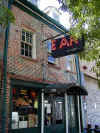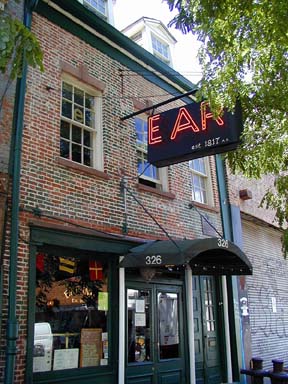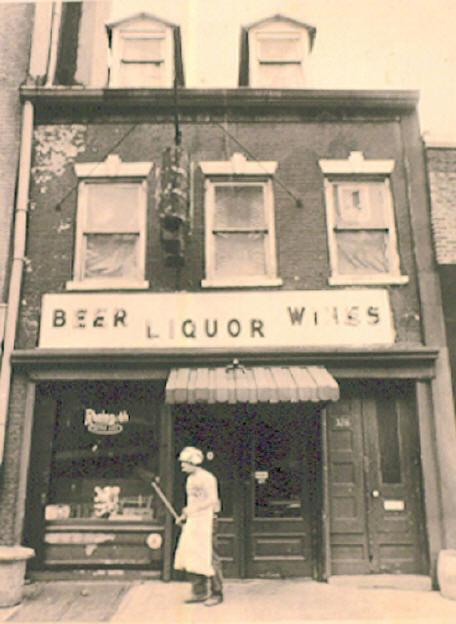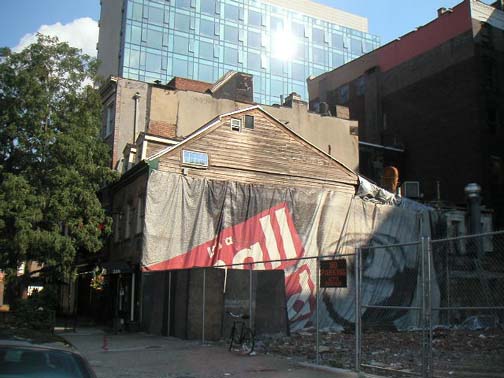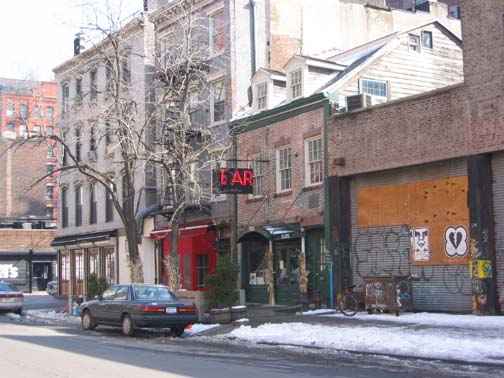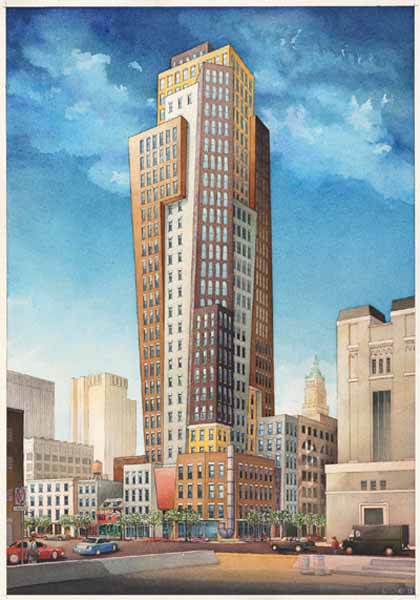|
|
Ear Inn has colorful
history and uncertain future
By Albert Amateau
Keeping a 186-year-old wooden beach house standing and functioning as
living quarters, office and pub is no easy task. Especially one condemned as
unfit for use back in 1906.
But Rip Hayman, owner of the James Brown House at 326 Spring St. gets
along, with a little help from friends.
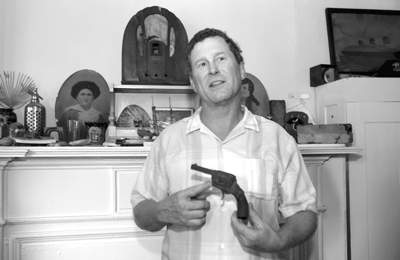
The house, built before 1817, is a designated landmark and the Ear Inn, a
pub on the ground floor, is a favorite neighborhood destination.
Recently, the Greenwich Village Society for Historic Preservation joined
with Hayman and Andy Coe — author of “Ear Inn Virons,” a book (as its
punning title indicates) about the history of the property and
neighborhood — in a guided tour of the building.
The three-story house, originally the home of an African-American
Revolutionary War veteran who ran a tobacco shop on the ground floor,
has uneven floors, stairs that slant at an odd angle and a unique
ambiance.
“This is sand from the foundation of the building,” said Hayman, holding a
beer stein full of grayish sand. The house, now a block and a half from
the Hudson River, was right on the riverbank in the early decades of the
19th century. “There was a sand spit in the river at Canal St. at that
time,” said Hayman. “We have to pump out the tide from the basement
twice a day.”
Hayman first rented a room in the house in 1973 when he was a Columbia
University student. He paid $100 a month rent to Harry Jacobs who ran
the unnamed pub known to neighbors as “The Green Door.” In 1977, Hayman
and friends bought the house and the pub.
“We were publishing ‘The Ear,’ a new music journal, at the time and we
decided to name the pub after it,” said Hayman. The city landmarks
commission didn’t allow new signage, so a coat of black paint covering
the curved neon tubes of the “B” in the pub’s BAR sign was sufficient
for EAR.
Although James Brown sold tobacco on the first floor, the shop has been a
pub for at least 150 years, said Hayman, who has a collection of whiskey
jugs found in the basement of the place. The records show there was a
bar in the building in 1835 and it was likely there for some years
before.
Hayman keeps a revolver, which he found several years ago tucked in the
flue of the second floor fireplace. “It’s a five-shot revolver made
around 1900,” he said. “I can imagine the circumstances when it was
hidden.”
Hayman, who is a principal in Odyssey Publications, a publishing firm with
offices in the James Brown House, is no longer active in the Ear Inn,
where he used to tend bar. Nevertheless, Martin Sheridan, who runs the
Ear, helps maintain the old house. It takes a lot of maintenance.
“We have crack gauges all over the walls,” Hayman said. “Whenever we have
engineers inspect the place they go, ‘Oh boy,’ and shake their heads.”
Hayman says he is worried most about the proposed redevelopment by Nino
Vendome of the adjacent property which shares a party wall with the old
house. Vendome first planned to build a 36-story tower designed by
Philip Johnson that would have cantilevered eight feet over the James
Brown House. The developer had a tentative agreement to replace plumbing
in the old house and provide space for a new exit and a kitchen
expansion for the Ear Inn as part of the redevelopment.
But Vendome failed to get a zoning variance for the building and now plans
an 11-story environmentally efficient building.
“When he builds it we’ll have to close and bring the whole building up to
code,” said Hayman. But help from the developer is not certain. “We may
not survive the construction unless we get help,” he said.
Andrew Berman, director of the G.V.S.H.P., agreed that the Vendome project
might threaten the James Brown house at 326 Spring St.
In a letter last week addressed jointly to Robert Tierney, Landmarks
Preservation Commission chairperson, and Patricia Lancaster, Department
of Buildings commissioner, Berman said, “The impending construction next
door at 328 Spring St. could easily pose a threat. Construction of this
planned 11-story building if not done with extreme care and regard for
the fragile state of the neighboring Ear Inn might easily damage or
undermine the landmark’s structural integrity.”
Berman called on the two agencies to work with Vendome and Hayman to
ensure that construction does not jeopardize survival of the house.
“After the building’s improbable and inspiring story of survival at this
location for almost 200 years, it would be tragic to see this historic
structure unnecessarily threatened now,” Berman said.
|
|
notes
|
(Adapted from “A Short History of Hudson Square” by the Friends of
Hudson Square.)
If you head south of Greenwich Village, west of
SoHo, and north of TriBeCa, you will find Hudson Square, the newest
district in New York City. This eclectic area is bordered by the
Hudson River to the west, Morton Street to the north, Canal Street
to the south, and Avenue of the Americas to the east. Although the
district is considered new, the community has a very rich history.
In 1705, Queen
Anne of England made a land grant of 215 acres to Trinity Church.
The Church Farm, to the north of the city proper, stretched from
Fulton Street to Christopher Street along the Hudson River, and was
mostly farmland and swamp. Although most of the farm was eventually
sold, Trinity is still the largest individual landowner in the
Hudson Square area.
By 1800, the community centering on Spring and Greenwich Streets was
a thriving market area known as Lower Greenwich. It was a working
class, racially mixed neighborhood south of the more affluent
Greenwich Village. Most of the buildings were Federal style
single-family homes with storefronts on the ground floor. Several
buildings still survive from this era, including the James Brown
House at 326 Spring Street (now home to the Ear Inn) as well as 486
and 488 Greenwich Street.
In the late 18th century, the area’s streets were named for now
historic figures such as the Dutch Governor Rip VanDam, then-mayor
of New York Colonel Varick, and William Houston, a delegate to the
Continental Congress. Richmond Hill, an elegant mansion that stood
at Charlton and Varick Streets, served as the headquarters for
General George Washington when he planned his battles in Long Island
during the Revolutionary War. It was later the home of John Adams,
Aaron Burr, and eventually John Jacob Astor, who subdivided the
estate and sold it for residential development in 1817.
Around this time, Trinity Church financed what is considered to be
New York’s first planned residential development surrounding a park
called Hudson Square, later known as St. John’s Park. The park stood
at what is now the entrance to the Holland Tunnel. The development
was similar in design to the Gramercy Park area. From the 1820s to
the 1830s, Hudson Square was the most desirable residential area in
the city.
With New York’s rapid expansion in the 19th century, the area was
completely connected to the city by the 1850s. Multiple dwellings
began to appear among the modest row houses in the working-class
neighborhood. Some of these tenements remain along Charlton, Broome,
and Spring Streets. Commerce grew in the area as well, with an
active market area blossoming and ships docking at the piers on
Canal and Clarkson Streets. Towards the end of the century, there
was an extensive trolley system along West Street, and New York’s
first elevated train ran up Greenwich Street.
|
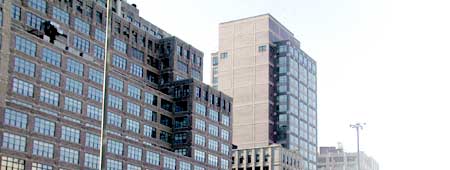 |
By 1900, however the area was rapidly becoming a slum. Tenements had
replaced many single-family homes. Trinity Church sold some of the
land it owned in the area, and began turning much of it’s remaining
holdings to commercial and manufacturing space.
In the 1920s, printers moved into Hudson Square because of the lower
rents. At their peak, the printers in the area produced about a
quarter of all the printing in the country. Around this time, the
neighborhood was dug up for the installation of the Holland Tunnel.
The tunnel brought a significant amount of automobile and commercial
traffic to the area, which is now home to United Parcel Service,
Federal Express, and Wall Street Mail.
Today, the Hudson Square neighborhood has a mixture of high-rise
commercial offices, loft industrial buildings mostly converted to
office use, and low-rise residential buildings. Building sizes range
from a few quaint two-story structures to twenty-plus story
monoliths. An eclectic mix of ad agencies, architects, filmmakers,
publishers, printers, software developers, and web designers
populate the business district, along with interesting shops,
restaurants, nightclubs, and art galleries.
Within the last twenty years, the area has renewed its residential
flavor. Numerous buildings have been converted from industrial to
residential use. In addition, the Charlton King Vandam Historic
District between Sixth Avenue and Varick Street contain the
Federal-style row houses that were once common throughout the area.
They are the remnants of the subdivision of the Richmond Hill
estate, a memento of Hudson Square’s storied past.
|
THE WOMEN OF LISPENARD'S
MEADOWS
One of the most intriguing
and evanescent legends about the Lower Greenwich neighborhood is the
tale of the Jackson Whites. When the British occupied New York during
the American Revolution, they had to keep satisfied the thousands of
British and Hessian troops billeted here. The story goes that military
authorities turned to a man named Jackson, who sailed for England where
he either enticed or kidnaped 3,500 British prostitutes. He then packed
them in 20 leaky old boats and sailed for the American Colonies. One
vessel sank in mid-ocean, so Jackson sent another boat to the West
Indies where it picked up a load of replacements, all of African origin.
When the prostitutes landed in New York, they were marched to
Lispenard's Meadows, where they found a large stockade encircling a
group of crude huts that would be their home. When soldiers were ready
for fun, they repaired to Lispenard's Meadows and knocked on the
stockade door for a few hours with the "Jackson Whites" or the "Jackson
Blacks". In 1783, when the British hurriedly evacuated New York,
somebody ran to Lispenard's Meadows and unlatched the stockade door,
releasing the unfortunate women. About 500 of the prostitutes trekked
north up the Hudson, while the remainder somehow crossed the river and,
three-thousandstrong, marched west into New Jersey, finally settling in
the nearby Ramapo Mountains. They were supposedly the ancestors of a
group still living in those hills known as the Jackson Whites or the
Ramapo Mountain People.
|
